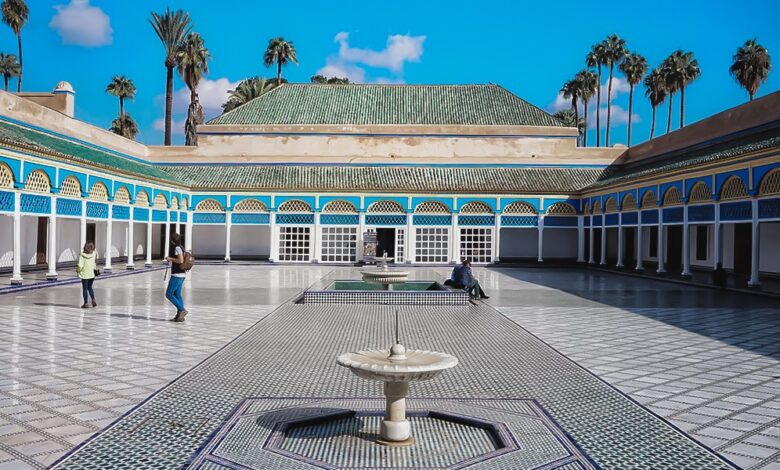Top 10 Marrakech Museums

Marrakech, a city steeped in history and vibrant culture, offers a fascinating journey through time and tradition. Beyond its bustling souks and serene gardens, the Red City boasts an impressive array of museums that delve into various facets of Moroccan life – from ancient arts and historical palaces to contemporary fashion and culinary heritage. Exploring these institutions provides a deeper understanding of Morocco’s rich past and its evolving present.
Here’s a detailed look at 10 of the best museums in Marrakech, each offering a unique window into the soul of this captivating city:
1. The Marrakech Museum (Musée de Marrakech)
Housed within the stunning Dar Menebhi Palace, a magnificent 19th-century residence known for its classical Andalusian architecture, the Marrakech Museum is a cultural cornerstone of the city. The palace itself is a work of art, with an expansive central courtyard adorned with intricate tilework (zellij), carved cedar wood, and a striking central chandelier. The museum’s collection is diverse, encompassing traditional Moroccan art, historical artifacts, archaeological finds, and ethnographic objects. Visitors can marvel at weapons, carpets, costumes, pottery from Fez, Berber jewelry, and even Jewish liturgical objects, offering a comprehensive glimpse into Morocco’s diverse cultural tapestry. The museum also hosts temporary exhibitions of contemporary art and cultural events, making it a dynamic hub for artistic exchange.
- Location: In the old city center, near the Ben Youssef Madrasa.
- Opening Hours: Generally 9 AM to 6 PM daily.
- Ticket Price: Around 70 MAD (approximately $7 USD).
2. Musée Yves Saint Laurent Marrakech (mYSLM)
A must-visit for fashion aficionados and anyone interested in the legacy of one of the 20th century’s most iconic designers, the Musée Yves Saint Laurent Marrakech pays homage to the legendary French couturier. Saint Laurent found immense inspiration in Marrakech, making it his second home. Designed by Studio KO, the museum’s architecture cleverly mimics the texture of fabric. Inside, a permanent exhibition showcases a rotating selection of Saint Laurent’s haute couture designs, original sketches, and prototypes from his collections spanning 1962 to 2002. Beyond fashion, the museum includes temporary exhibition spaces, a research library with over 5,000 volumes, a 140-seat auditorium, a bookshop, and a charming terrace cafe. It’s ideally located next to the famous Jardin Majorelle, allowing for a combined visit.
- Location: Rue Yves St Laurent, near Jardin Majorelle.
- Opening Hours: Generally 10 AM to 6 PM daily, closed Wednesdays.
- Ticket Price: Combined tickets with Jardin Majorelle are common and recommended.
3. Pierre Bergé Museum of Berber Arts (Musée Berbère Jardin Majorelle)
Situated within the iconic Jardin Majorelle’s vibrant blue villa (the former studio of artist Jacques Majorelle), this museum offers a profound insight into the rich culture and history of Morocco’s indigenous people, the Amazigh (Berber). The museum houses an extensive collection of over 600 artifacts amassed by Yves Saint Laurent and his partner, Pierre Bergé. Exhibits include traditional clothing, jewelry, musical instruments, pottery, and everyday items, all meticulously curated to tell the story of the Amazigh’s enduring traditions. The jewelry section, with its sparkling gems and a ceiling designed to evoke a starry desert night, is a particular highlight. It’s a poignant and informative exploration of a vital part of Moroccan identity.
- Location: Inside Jardin Majorelle.
- Opening Hours: Generally 9 AM to 5:30 PM daily.
- Ticket Price: Combined ticket required for entry to Jardin Majorelle and the museum. Pre-booking online is advised.
4. Bahia Palace
While technically a palace rather than a museum in the traditional sense, the Bahia Palace is an absolute masterpiece of Moroccan architecture and a living museum of imperial grandeur. Built in the late 19th century for Si Moussa, Grand Vizier of the Sultan, and later expanded by his son Ahmed ben Moussa, the palace spans eight hectares with approximately 150 richly decorated rooms. It’s renowned for its exquisite courtyards, serene gardens, intricate wooden ceilings, carved stucco, and vibrant zellij tilework. Exploring its various courtyards, living quarters, and reception halls offers a captivating glimpse into the lavish lifestyle of Moroccan royalty and aristocracy from that era. The “Cour d’Honneur,” with its stunning Carrara marble, is a particular highlight.
- Location: Avenue Imam El Ghazali, in the Medina.
- Opening Hours: Generally 9 AM to 4:45 PM daily.
- Ticket Price: Around 70 MAD (approximately $7 USD).
5. Dar El Bacha – Musée des Confluences
Once the opulent residence of Thami El Glaoui, the powerful Pasha who governed Marrakech from 1912 to 1956 and famously entertained guests like Winston Churchill and Charlie Chaplin, Dar El Bacha has been transformed into the Musée des Confluences. This museum focuses on the convergence of cultures, showcasing various exhibitions that highlight the cultural exchanges between Morocco, the Arab world, and beyond. The palace itself is a magnificent example of riad architecture, with beautiful gardens and traditional Moroccan decoration that make it a peaceful retreat. A notable addition is the Bacha Coffee House, a beautiful space to enjoy coffee and breakfast within the historical setting.
- Location: Rue Lalla Fatima Zahra, in the Medina.
- Opening Hours: Generally 10 AM to 6 PM, closed Mondays.
- Ticket Price: Varies depending on exhibitions.
6. Maison de la Photographie (Photography Museum)
For a unique visual journey through Morocco’s past, the Maison de la Photographie is a hidden gem. Created by two Parisian collectors, Patrick Menac’h and Hamid Mergani, this charming museum is housed in a beautifully restored traditional riad in the Medina. It showcases a private collection of over 4,500 photographs, 2,000 glass negatives, and 80 vital documents, all focusing on Morocco from 1870 to 1950. The collection vividly captures old archaeological sites, rare Moroccan landscapes, and portraits of locals, providing a compelling visual narrative of the country’s evolution. The museum also has a rooftop terrace with panoramic views, perfect for a refreshing mint tea after your visit.
- Location: Rue Bin Lamdoune, in the Medina.
- Opening Hours: Generally 9 AM to 7 PM daily.
- Ticket Price: Around 50 MAD (approximately $5 USD).
7. Museum of African Contemporary Art Al Maaden (MACAAL)
For those interested in modern and contemporary art, MACAAL offers a refreshing departure from traditional Moroccan museums. Located outside the city, it’s worth the short taxi ride. The museum, which reopened in February 2025 after structural reinforcements, provides a permanent home for the Lazraq family’s extensive private collection of African art. Its earth-textured buildings house eight exhibition spaces across two floors, featuring innovative and thought-provoking artists from across the African continent. MACAAL aims to promote Africa’s creative spirit, foster conversations, and bring the community together through its bright and engaging displays.
- Location: Al Maaden, 5km outside the city (taxi recommended).
- Opening Hours: Wednesday to Sunday, 10 AM to 6 PM.
- Ticket Price: Varies by exhibition, generally around 70 MAD.
8. Dar Si Said Museum (Museum of Moroccan Arts)
Considered the oldest museum in Marrakech, Dar Si Said, also known as the Museum of Moroccan Arts, is nestled within a former 19th-century palace. It offers an in-depth exploration of Moroccan artisanal craftsmanship. The museum boasts a rich collection of traditional Moroccan arts and crafts, including woodwork, carpets, jewelry, ceramics, and leather goods from various regions and eras. Its tranquil courtyards and intricate architectural details provide a serene backdrop for appreciating the skill and artistry of Moroccan artisans throughout history. It’s often described as a “hidden secret” compared to more famous attractions, offering a quieter, more intimate cultural experience.
- Location: 8 Rue de la Bahia, in the Medina.
- Opening Hours: Generally 10 AM to 6 PM, closed Tuesdays.
- Ticket Price: Around 70 MAD (approximately $7 USD).
9. Moroccan Culinary Arts Museum
A charming addition to Marrakech’s museum scene, the Moroccan Culinary Arts Museum is housed in a former 18th-century palace in the Kasbah district. This unique museum celebrates Morocco’s rich culinary heritage through informative permanent exhibitions showcasing the country’s cherished dishes, ingredients, and traditions. Beyond the displays, the museum offers a hands-on experience with daily cooking classes conducted in a state-of-the-art, open-plan kitchen. Visitors can learn to prepare traditional Moroccan dishes and then enjoy their creations on the rooftop terrace. There’s also a courtyard cafe and restaurant for those who prefer to simply savor the flavors.
- Location: Kasbah district.
- Opening Hours: Classes run at 9 AM, 11 AM, and 3 PM. Museum hours typically align.
- Ticket Price: Varies depending on whether you take a cooking class or simply visit the museum/restaurant.
10. Musée du Parfum (Perfume Museum)
For a truly unique sensory experience, the Musée du Parfum is a delightful stop. Located in a charming 19th-century riad on a quiet Medina street, this elegant museum celebrates Morocco’s deep connection with plant medicine, fragrance, and beauty rituals. Founded by botanist and perfumer Abderrazzak Benchaâbane (who worked with Yves Saint Laurent at Jardin Majorelle), the museum shares his devotion to the delicate art of perfume-making. Through visual displays, photos, and scents, visitors can discover the flowers, spices, and techniques used to distill essential oils, as well as the intricate steps involved in creating perfumes. For an additional fee, you can even participate in a workshop to create your bespoke scent.
- Location: In the Medina.
- Opening Hours: Typically daily, but checking in advance is recommended.
- Ticket Price: Entry fee, with additional cost for workshops.
Marrakech’s museums offer an enriching and diverse cultural experience, inviting visitors to delve deeper into the city’s artistic, historical, and traditional soul. From ancient palaces to contemporary art spaces, each institution tells a compelling story, ensuring that your visit to the Red City is not just visually stunning but also intellectually stimulating.





